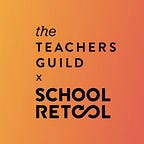The Bay Area Discovery Museum Goes Mobile
Designing an Engineering Experience for All Learners
by Anastassia Radeva
Anastassia Radeva is the Elementary Engineering Specialist at the Bay Area Discovery Museum, a nonprofit children’s museum positioned at the intersection of STEM and creativity and a partner in the Teachers Guild and 100kin10’s Collaboration to design active and authentic STEM learning experiences.
At the Bay Area Discovery Museum, we believe that STEM education is an integral part of developing creativity, critical thinking, and problem solving skills in our young learners. As the Elementary Engineering Specialist at the museum, I am developing a new off-site, mobile educational program geared at providing early engineering educational experiences to children, educators, and caregivers. I’m so excited about this project because it will bring joyful and hands-on, minds-on experiences directly to schools and communities, and because we’ve been developing it directly with teachers.
Our program idea arose from the question: “how can we demystify engineering for students and teachers in the elementary school space?” Our response to this important question was to create a program that can provide hands-on, interest-building engineering experiences that can travel between schools, community organizations, and public spaces to bring high-quality engineering education directly to users. We landed on creating a mobile engineering lab program based upon feedback from teacher partners, who expressed that having easy, affordable access to educational experiences that model high-quality engineering learning is important. The project then continued to evolve through testing, feedback, and iteration.
Feedback from our end users — in this case, our teacher and educator community — was really important as we developed our idea. We collected feedback through a series of focus groups with teachers, STEM coordinators, and administrators. This taught us that a mobile vehicle equipped to facilitate a wide variety of engineering programs would be exciting and unintimidating for teachers, students, and the broader community. We also conducted a series of collaborative visits to other mobile educational programs, including the Golden Gate National Recreation Area’s Roving Rangers, UC-Davis’ Beta Lab, Stanford University’s Sparktruck, and the San Francisco Public Library’s Techmobile, to learn about challenges, affordances, and tips about creating a similar initiative.
To test and iterate our idea, we are developing curriculum units and actively testing them with local elementary school classrooms in the coming months. We are experimenting with a wide variety of program offerings, from one-day engineering extravaganzas that all students at an elementary school site can participate in, to multi-day, intensive visits oriented at specific grade levels. We will also be testing and improving our idea through full pilots this upcoming spring with school site partners in rural and urban locations throughout the Bay Area.
Help us continue to learn! Here are some questions for you:
- When you hear “mobile engineering lab”, what do you think that means?
- What words, images, or feelings come to mind?
- If this mobile educational program showed up in your community, what do you think would happen during this experience?
As you embark on your own design journey, know this: you will fail, and THAT’S OK! Fail early, and fail often, because that’s how you will develop a well-rounded and tested idea. When you do fail, don’t shut down — use this as an opportunity to hone in on what DOES work and what could be better or different.
Learn more and get involved in our Collaboration on active and authentic STEM here.
